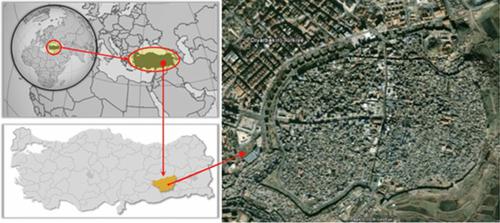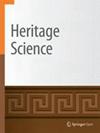Damage assessment and restoration proposal following the 2023 Türkiye earthquakes: UNESCO World Heritage Site Diyarbakır City Walls, Türkiye
IF 2.6
1区 艺术学
Q2 CHEMISTRY, ANALYTICAL
引用次数: 0
Abstract
Abstract Diyarbakır City Walls, one of the longest defensive structures in the world, following the Great Wall of China, the walls of Antakya, and the walls of Istanbul, is a UNESCO World Heritage site since 2015. With a history of approximately 5000 years, the Diyarbakır City Walls have been affected by consecutive earthquakes centered in Kahramanmaraş in 2023, resulting in damages to various sections. Urgent restoration and repair interventions are needed for these sections of the Diyarbakır City Walls due to earthquake-induced damages. Although there are limited studies presenting stone analysis of the Diyarbakır City Walls in the literature, no studies focusing on mortar analysis have been found. The objectives of this study are as follows: (I) to identify the mechanisms and factors of earthquake damages in the Diyarbakır City Walls, (II) to conduct necessary analyses for the selection of mortar materials for post-earthquake repairs, and (III) to provide restoration and strengthening recommendations to ensure the sustainability of the original structure. Observational, petrographic, chemical, and SEM analysis techniques were used, and the findings were interpreted comparatively. The results demonstrate that the most severe damages after the earthquake in the Diyarbakır City Walls were caused by the inadequate adhesion of missing mortar joints and different types of materials used between double-walled structures. Additionally, the presence of clay minerals identified in the mineralogy of the mortar through experimental analysis was defined as an internal issue causing the loss of mortar due to osmotic pressure created by water absorption. Another factor causing the loss of mortar is the presence of chloride-type salts, which were found to be present in a significant amount in all samples and were attributed to the use of Portland cement in previous faulty repairs. It was also determined that recent faulty repointing works contributed to the loss of mortar. Finally, this article presents original restoration and strengthening recommendations to repair the earthquake-induced damages and prevent their reoccurrence in the future.

2023年基耶地震后的损害评估和修复建议:联合国教科文组织世界遗产Diyarbakır城墙,基耶
摘要Diyarbakır城墙是继中国长城、安塔基亚城墙和伊斯坦布尔城墙之后,世界上最长的防御结构之一,自2015年以来被联合国教科文组织列为世界遗产。拥有大约5000年历史的Diyarbakır城墙在2023年以kahramanmaraku为中心的连续地震中受到影响,导致各个部分受损。由于地震引起的破坏,需要对Diyarbakır城墙的这些部分进行紧急恢复和修复干预。虽然文献中对Diyarbakır城墙进行石材分析的研究有限,但尚未发现针对砂浆分析的研究。本研究的目的是:(1)确定Diyarbakır城墙地震破坏的机制和因素;(2)对震后修复砂浆材料的选择进行必要的分析;(3)提供修复和加固建议,以确保原有结构的可持续性。利用观测、岩相、化学、扫描电镜等分析技术,对发现进行了比较解释。结果表明:Diyarbakır墙体地震后最严重的破坏是由于缺失的砂浆缝粘结不良和双层墙体结构之间使用的材料类型不同造成的。此外,通过实验分析在砂浆矿物学中发现的粘土矿物的存在被定义为由于吸水产生的渗透压而导致砂浆损失的内部问题。造成砂浆流失的另一个因素是氯化物盐的存在,在所有样品中都发现了大量氯化物盐,这是由于在之前的错误修复中使用了波特兰水泥造成的。还确定,最近错误的重新定位工作导致了砂浆的损失。最后,本文提出了原有的修复和加强建议,以修复地震造成的损害,防止将来地震再次发生。
本文章由计算机程序翻译,如有差异,请以英文原文为准。
求助全文
约1分钟内获得全文
求助全文
来源期刊

Heritage Science
Arts and Humanities-Conservation
CiteScore
4.00
自引率
20.00%
发文量
183
审稿时长
19 weeks
期刊介绍:
Heritage Science is an open access journal publishing original peer-reviewed research covering:
Understanding of the manufacturing processes, provenances, and environmental contexts of material types, objects, and buildings, of cultural significance including their historical significance.
Understanding and prediction of physico-chemical and biological degradation processes of cultural artefacts, including climate change, and predictive heritage studies.
Development and application of analytical and imaging methods or equipments for non-invasive, non-destructive or portable analysis of artwork and objects of cultural significance to identify component materials, degradation products and deterioration markers.
Development and application of invasive and destructive methods for understanding the provenance of objects of cultural significance.
Development and critical assessment of treatment materials and methods for artwork and objects of cultural significance.
Development and application of statistical methods and algorithms for data analysis to further understanding of culturally significant objects.
Publication of reference and corpus datasets as supplementary information to the statistical and analytical studies above.
Description of novel technologies that can assist in the understanding of cultural heritage.
 求助内容:
求助内容: 应助结果提醒方式:
应助结果提醒方式:


